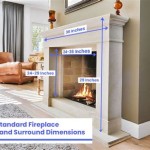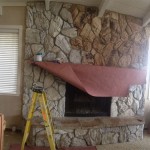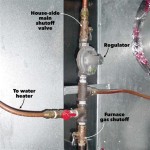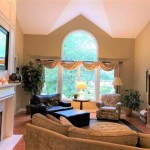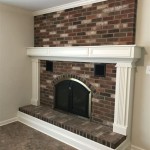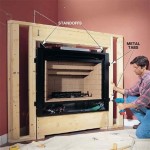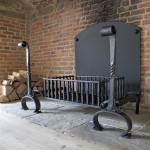Installing a Wood Burning Stove in an Existing Fireplace
Integrating a wood-burning stove into an existing fireplace can be a cost-effective and aesthetically pleasing way to enhance home heating. This installation offers several advantages, including increased heating efficiency, reduced emissions compared to open fireplaces, and the preservation of the fireplace's original character. However, a successful installation requires careful planning, adherence to safety regulations, and a thorough understanding of the necessary steps.
Before beginning any installation, it's crucial to assess the existing fireplace and chimney. This assessment involves a detailed inspection of the fireplace's structural integrity, including the firebox, hearth, and surrounding masonry. Any cracks, crumbling bricks, or other signs of deterioration need to be addressed before proceeding. Similarly, the chimney must be inspected for blockages, cracks, or creosote buildup. A professional chimney sweep can perform a thorough inspection and cleaning, ensuring the chimney is safe and ready for use with a wood-burning stove.
Furthermore, ensuring the fireplace opening is large enough to accommodate the chosen wood-burning stove is paramount. Measure the dimensions of the fireplace and compare them to the stove's dimensions, allowing adequate clearance for installation, operation, and future maintenance. It is equally important to verify that the hearth is non-combustible and extends far enough into the room to protect flooring from embers and sparks. Local building codes dictate the specific hearth requirements.
Key Point 1: Selecting the Right Wood Burning Stove
Choosing the appropriate wood-burning stove is a pivotal element in the installation process. Several factors must be considered, including the size of the space to be heated, the desired heat output, and the stove's efficiency rating. Stoves are typically rated in terms of British Thermal Units (BTUs), which indicate the amount of heat they can produce per hour. Overestimating the required BTU output can lead to an overheated space, while underestimating it will result in insufficient heating.
Moreover, consider the type of wood-burning stove that best suits the aesthetic and functional needs. Options include freestanding stoves, insert stoves designed specifically for fireplace installations, and EPA-certified stoves, which meet stringent emission standards. Insert stoves typically slide into the fireplace opening and are designed to provide efficient heat output while maintaining a traditional look. EPA-certified stoves are generally more expensive but offer significant environmental benefits and may qualify for tax credits or rebates.
Prior to purchasing a stove, it is recommended to consult with a qualified professional. This expert can assess the home's heating needs, recommend suitable stove models, and ensure compliance with local building codes and regulations. This consultation helps avoid costly mistakes and guarantees safe and efficient operation of the wood-burning stove.
Key Point 2: Preparing the Fireplace and Chimney
Preparing the existing fireplace and chimney system is a crucial step in ensuring a safe and efficient installation. This process often involves installing a chimney liner, which is a metal pipe that runs the length of the chimney and connects directly to the stove's flue outlet.
Chimney liners are highly recommended for several reasons. Older chimneys can have cracks or gaps that allow dangerous gases and creosote to leak into the home. A liner provides a sealed flue pathway, preventing these hazards. Additionally, a properly sized chimney liner optimizes the stove's draft, enhancing combustion efficiency and reducing the risk of backdrafting. Backdrafting can occur when exhaust gases are drawn back into the home, posing a serious health risk.
The installation of a chimney liner typically requires professional expertise. The liner must be sized correctly to match the stove's flue outlet dimension. It is also important to choose a liner material that is compatible with wood-burning stoves, such as stainless steel. The liner should be properly insulated to prevent excessive heat loss and further reduce the risk of creosote buildup. Improper installation of a chimney liner can lead to safety hazards and void the stove manufacturer's warranty.
Before installing the liner, the chimney should be thoroughly cleaned to remove any creosote or debris. This cleaning is essential for ensuring proper draft and preventing chimney fires. A professional chimney sweep can perform this cleaning and identify any potential issues with the chimney's structure or condition. Addressing these issues before installing the stove is crucial for long-term safety and performance.
Key Point 3: Installing the Wood Burning Stove
The stove installation process typically involves placing the stove within the fireplace opening, connecting it to the chimney liner, and ensuring proper sealing. Careful attention to detail is essential to prevent air leaks and ensure optimal performance. Once the chimney liner is properly installed and connected to the stove's flue outlet with appropriate connectors, it should be sealed tightly around the stove's flue collar. High-temperature sealant or stove cement should be used to create an airtight seal.
The clearance around the stove is also critical. Most stoves require a certain amount of clearance from combustible materials, such as walls and mantlepieces. These clearance requirements are specified by the stove manufacturer and detailed in the installation manual. Failure to follow these guidelines can pose a fire hazard. Heat shields can be used to reduce the required clearances and protect nearby combustible materials.
After the stove is installed, it is crucial to perform a test burn to verify functionality and ensure proper draft. During the test burn, monitor the stove's performance, check for any leaks or unusual odors, and ensure that the chimney is drawing properly. It is also important to familiarize oneself with the stove's operating instructions and safety precautions. Proper operation and maintenance are essential for ensuring the stove's longevity and safe performance.
The process of properly installing a wood-burning stove inside a fireplace can be complex, but the benefits of added warmth and energy efficiency make it well worth the effort. It's crucial to prioritize safety, comply with local building codes, and consider seeking professional assistance when needed, to achieve optimal results for a safe and enjoyable heating system.

Can You Install A Wood Stove In Fireplace Direct Stoves

Can You Install A Wood Stove In Fireplace Direct Stoves

Converting A Fireplace To Wood Burning Stove Chesneys

Can You Install A Wood Stove In Fireplace Direct Stoves

Converting A Fireplace To Wood Burning Stove Chesneys

Can You Install A Wood Stove In Fireplace Direct Stoves

Woodburner Installations In Victorian Fireplaces Cosy Stoves

Choosing And Installing Our Wood Burning Stove Salt Rook

Victorian Fireplace Hobbit Installation Small Stoves

How To Prepare A Chimney For Wood Burning Stove Houzz Ie

